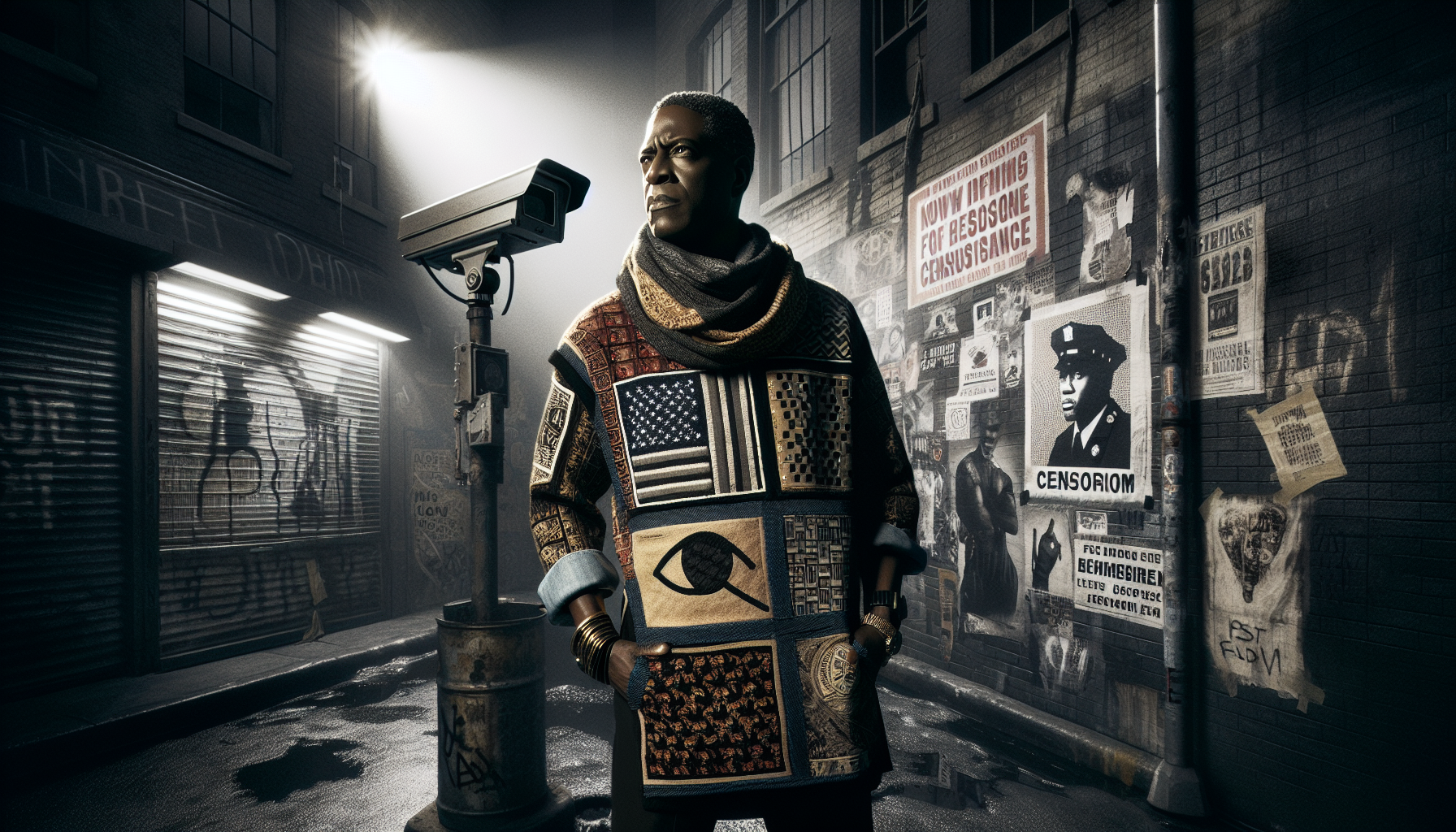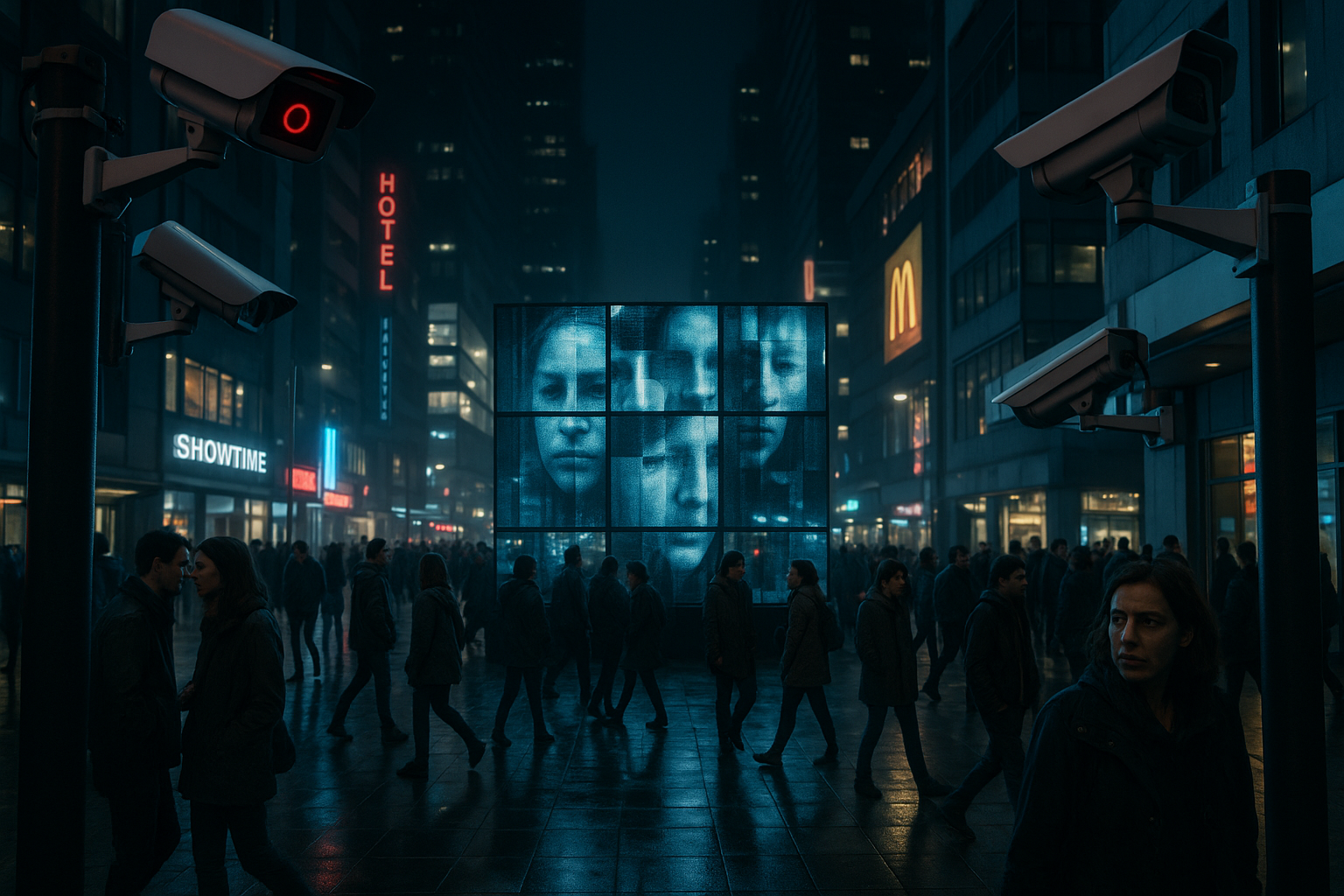Anúncios
In a world where our voices are often subdued by societal norms and political constraints, fashion emerges as a vibrant and defiant language that speaks louder than words. Clothes are no longer just fabrics stitched together to cover our bodies; they have evolved into powerful tools of expression and resistance. Welcome to “Fashion Unleashed: How Clothing Can Be a Powerful Political Statement in the Face of Censorship,” where we delve into the intricate relationship between fashion and politics, exploring how attire transcends mere aesthetics to become a symbol of defiance, identity, and change. 👗✊
Anúncios
Imagine walking down a bustling city street, where every passerby is a canvas of colors, patterns, and styles. While some might see this as a simple parade of trends, beneath the surface lies a tapestry of stories and statements. From the suffragettes of the early 20th century, donning white dresses as a symbol of purity and virtue in their fight for voting rights, to the Black Panthers of the 1960s, whose leather jackets and berets became icons of empowerment and resistance, fashion has been a pivotal player in shaping political discourse. These garments do more than adorn bodies; they challenge oppressive norms, spark dialogues, and inspire movements. In this article, we will unravel how clothing has historically served as a form of protest and how it continues to be a beacon of hope and change in modern times.
Anúncios
But how does one piece of clothing become a political statement? It’s a question that resonates with designers, activists, and everyday individuals who harness fashion as a medium of expression. In the face of censorship, where words may be stifled, fashion becomes an unspoken language that defies silencing. We’ll explore the role of iconic fashion moments that have disrupted the status quo and examine the courage of individuals who use their wardrobes as battlegrounds for rights and freedoms. From the feminist T-shirts that boldly declare “The Future is Female” to the hijabs worn by women asserting their rights to religious freedom and identity, fashion is a dynamic and democratic platform for advocacy.
As we navigate through this vibrant intersection of fashion and politics, prepare to be inspired by the audacity and creativity of those who refuse to be muted. We’ll delve into the stories of designers who have embraced their craft as a form of activism, as well as everyday heroes who use their style to challenge injustices. Whether it’s through a daring color choice, an avant-garde silhouette, or a repurposed fabric, each fashion statement is a testament to the resilience of the human spirit. So, join us on this journey as we celebrate the transformative power of fashion and its unyielding spirit in the face of censorship. 🌟👠
The Power of Fashion as a Political Statement
Fashion has always been more than just a means of self-expression or a pursuit of aesthetics. Throughout history, it has served as a powerful tool for political commentary and resistance, a silent yet profound way to voice dissent or align oneself with certain ideologies. The clothes we wear can speak volumes, offering a canvas for messages that transcend words, particularly in environments where freedom of speech may be restricted or censored. As societies evolve, fashion continues to be an essential medium through which individuals and groups can challenge norms, provoke thought, and inspire change.
In many cultures, clothing has been used to signify social status, political affiliations, or ideological leanings. From the suffragettes wearing white to signify purity and solidarity to the Black Panther Party adopting leather jackets and berets as a form of unity and empowerment, the symbolism inherent in fashion is potent. In more recent years, the Pussyhat Project, with its distinct pink knitted hats, became an emblem of the Women’s Marches, symbolizing resistance against sexism and support for women’s rights. These examples illustrate how fashion can unify people under a common cause, creating a visual language that speaks to shared beliefs and aspirations.
Fashion’s role as a political statement becomes even more critical in environments where censorship is prevalent. In such contexts, where overt dissent might lead to severe repercussions, clothing can offer a subversive form of resistance. For instance, wearing certain colors or styles can subtly challenge authority or highlight societal issues without directly violating censorship laws. This covert approach allows individuals to express their discontent and rally others to their cause, creating a sense of community and solidarity among those who oppose oppressive regimes.
Historical Context: Clothing as a Tool of Dissent
The historical roots of fashion as a political statement are deep and varied. Throughout the 20th century, clothing was used strategically to oppose oppressive regimes and challenge the status quo. For instance, during the 1960s civil rights movement in the United States, African American activists used fashion to assert their identity and demand equality. They embraced traditional African garments, such as dashikis, to promote cultural pride and resist assimilation into a predominantly white society. This sartorial choice was a direct challenge to the societal norms of the time, symbolizing a rejection of systemic racism and an affirmation of black identity.
In other parts of the world, fashion has similarly been used as a form of resistance. In South Africa during the apartheid era, anti-apartheid activists adopted the “Black Consciousness” movement’s style, which included the wearing of black berets and other symbolic garments. These fashion choices were a form of protest against racial segregation and oppression, sending a message of solidarity and resistance to the ruling government. In these instances, clothing became a tool for political mobilization, uniting people under a common cause and reinforcing their resolve to fight for justice.
The use of fashion as a political statement is not limited to historical movements. In contemporary society, fashion continues to serve as a platform for activism and dissent. For example, the rise of fast fashion and its environmental impact have spurred movements advocating for sustainable and ethical fashion practices. Activists and designers are using fashion to raise awareness about the detrimental effects of the fashion industry on the environment, urging consumers to make more conscious choices. In this context, fashion becomes a vehicle for promoting social and environmental responsibility, encouraging individuals to rethink their consumption habits and support more sustainable alternatives.
Contemporary Examples of Political Fashion
Today, fashion remains a powerful tool for political expression, with designers and consumers alike using clothing to address pressing social and political issues. One notable example is the rise of the “Black Lives Matter” movement, which has inspired a wave of fashion activism. Designers and brands have created collections featuring slogans and imagery that support the movement, using fashion to amplify the voices of marginalized communities and call for systemic change. These garments serve as a form of protest, challenging racial injustice and demanding accountability from those in power.
Another contemporary example is the use of fashion to advocate for LGBTQ+ rights. Pride parades around the world have become vibrant displays of self-expression, with participants using clothing to celebrate their identities and challenge societal norms. Fashion designers have embraced this movement, creating collections that celebrate diversity and inclusivity, often featuring rainbow motifs and other symbols of LGBTQ+ pride. Through fashion, individuals can assert their identities and demand equal rights, using clothing as a means of resistance against discrimination and intolerance.
In addition to these movements, fashion is also being used to address environmental and ethical concerns. The growing awareness of the fashion industry’s impact on the environment has led to a rise in sustainable fashion initiatives. Designers are creating collections using eco-friendly materials and ethical production practices, promoting a more sustainable and responsible approach to fashion. This shift in focus highlights the potential of fashion to drive positive change, encouraging consumers to make more conscious choices and support brands that prioritize environmental and social responsibility.
Fashion in the Face of Censorship
In regions where freedom of expression is limited, fashion can serve as a covert form of dissent. Clothing becomes a silent protest, allowing individuals to challenge oppressive regimes and express their discontent without directly violating censorship laws. This form of resistance is particularly important in authoritarian regimes, where dissent can be met with severe repercussions. By using clothing as a medium for protest, individuals can subtly challenge authority and rally others to their cause, creating a sense of solidarity and community among those who oppose the regime.
One example of this phenomenon is the use of color as a form of protest. In countries where political dissent is heavily censored, wearing a particular color can symbolize resistance against the government. This strategy was employed during the 2009 Iranian presidential election protests, where green became a symbol of opposition to the regime. Protesters wore green clothing and accessories to show their support for the reformist candidate and their rejection of the election results. This subtle yet powerful use of fashion allowed individuals to express their dissent and unite under a common cause.
Fashion can also be used to challenge societal norms and advocate for social change in the face of censorship. In countries where gender norms are strictly enforced, clothing can be used to defy traditional gender roles and promote gender equality. For example, in some Middle Eastern countries, where women are required to wear conservative clothing, wearing more progressive styles can be a form of resistance against gender inequality. These sartorial choices challenge societal expectations and promote a more inclusive and equitable society, using fashion as a means of advocating for change.
| Political Movement | Fashion Symbolism | Impact |
|---|---|---|
| Suffragette Movement | White clothing for purity and solidarity | Helped unify and amplify the message for women’s voting rights |
| Black Panther Party | Leather jackets and berets | Symbolized unity, power, and resistance against racial oppression |
| Women’s Marches | Pussyhats | Emphasized women’s rights and solidarity against sexism |
| Black Lives Matter | Fashion with slogans and imagery | Amplified the call for racial justice and systemic change |
The Role of Designers in Political Fashion
Designers play a crucial role in using fashion as a tool for political expression. By creating collections that address social and political issues, designers can use their platforms to amplify marginalized voices and advocate for change. This approach not only raises awareness about important issues but also encourages consumers to engage with fashion in a more meaningful and intentional way.
One example of a designer who has used fashion as a political statement is Vivienne Westwood. Known for her punk-inspired designs, Westwood has consistently used her collections to challenge societal norms and advocate for environmental and social causes. Her fashion shows often feature bold political statements, urging consumers to consider the impact of their choices and take action to address pressing issues. Through her work, Westwood demonstrates the power of fashion to provoke thought and inspire change, using clothing as a platform for activism and advocacy.
In addition to established designers, emerging designers are also using fashion to address social and political issues. Many young designers are prioritizing sustainability and ethical production practices, creating collections that challenge the traditional fashion industry model. By promoting more responsible and conscious consumption, these designers are using fashion to advocate for environmental and social justice, encouraging consumers to support brands that align with their values.
Conclusion
In conclusion, “Fashion Unleashed: How Clothing Can Be a Powerful Political Statement in the Face of Censorship” has traversed the multifaceted landscape where fashion intersects with political expression. Throughout this article, we have delved into the historical context, contemporary examples, and potential implications of using clothing as a medium to challenge censorship and convey powerful messages. From the rebellious elegance of the suffragette movement to the vibrant assertion of identity in LGBTQ+ parades, fashion has consistently served as a silent yet potent megaphone for those who dare to defy oppressive norms.
We began by exploring the historical underpinnings of fashion as a form of resistance. Clothing has long been a canvas for individuals and groups to express dissent, as seen in the emblematic white dresses of suffragettes or the black turtlenecks of the Black Panthers. These sartorial choices were not merely aesthetic but deliberate acts of defiance against societal constraints. They were visual statements that resonated far beyond their immediate circles, echoing the desires for equality, justice, and reform.
Moving into contemporary times, the role of fashion in political discourse has evolved yet remains deeply significant. The rise of social media has amplified the impact of sartorial choices, turning local acts of rebellion into global phenomena. For instance, the #BlackLivesMatter movement has seen individuals and designers alike using clothing to support and spread their message of racial equality. Similarly, the hijab has become a symbol of both personal faith and political resistance in the face of growing Islamophobia. These examples underscore the transformative power of fashion to transcend mere aesthetics and become a language of its own, challenging viewers to reflect and react.
The article also touched upon the challenges faced by those who use fashion as a tool for political expression. In many regions, censorship laws and societal pressures can stifle such expressions, putting individuals at risk. Yet, it is in these restrictive environments that fashion becomes even more critical as a form of silent protest. Designers and wearers alike find ingenious ways to circumvent censorship, using symbols, colors, and patterns to convey messages that might otherwise be silenced.
The importance of understanding and harnessing the power of fashion in political contexts cannot be overstated. Clothing, as a form of non-verbal communication, possesses the unique ability to cross cultural and linguistic barriers. It speaks a universal language of defiance, unity, and hope, capable of galvanizing movements and inspiring change. In an era where voices are often stifled by oppressive regimes, fashion provides an alternative platform for expression, empowering individuals to make bold statements without uttering a single word.
As we reflect on the narratives shared in this article, it becomes evident that fashion is not just about fabric and style; it is a dynamic form of art and activism. It is a testament to human creativity and resilience, showcasing the indomitable spirit of those who dare to speak out through their attire. Whether it’s a simple T-shirt emblazoned with a powerful slogan or an intricately designed garment rich with symbolism, fashion has the potential to ignite conversations and foster understanding across diverse communities.
We encourage you, the reader, to consider the clothes you wear not just as items of personal expression but as potential vehicles for change. Whether you’re attending a rally, supporting a cause, or simply going about your daily life, remember that your sartorial choices have the power to influence and inspire. Share your thoughts and experiences on how fashion has impacted your own life or the world around you. Engage with others in discussions about the political implications of clothing and explore the myriad ways in which you can use fashion as a tool for advocacy.
Moreover, we invite you to share this article with friends, family, and colleagues who might be interested in the intersection of fashion and politics. By doing so, you contribute to a broader dialogue about the role of clothing in societal change, encouraging more people to recognize and harness its potential.
In closing, let us embrace fashion as a vibrant and dynamic force in the ongoing struggle for freedom and equality. Let it be a reminder that even in the face of censorship and repression, creativity and expression can never be fully stifled. Together, we can continue to use fashion to challenge the status quo, celebrate diversity, and advocate for a more just and inclusive world. 🌍✨
For further reading and to deepen your understanding of the topics discussed, consider exploring reputable sources such as The Business of Fashion and Fashion Revolution, which offer insightful analyses and reports on the evolving role of fashion in global political landscapes.

Toni Santos is a visual storyteller and artisan whose work reimagines fashion in the aftermath of civilization. Exploring the aesthetics of survival, decay, and resilience, Toni crafts wearable narratives shaped by a post-human world — where utility meets myth, and remnants become ritual.
Drawn to the raw beauty of collapse and adaptation, Toni’s creations emerge from imagined futures and forgotten pasts. Torn fabrics, corroded metals, and salvaged textures form the foundation of a style that speaks not just to what is worn — but to what has endured. Each piece tells a story of transformation, of identity reshaped by ruins and time.
Through garments, accessories, and visual compositions, Toni constructs a language of dress where fashion is not decoration but declaration — a symbol of survival, memory, and the human spirit persisting in desolation. With a background in visual design and handcrafted techniques, Toni blends precision with provocation. His works are tactile philosophies, designed to be worn, felt, and remembered.
As the creative voice behind Vizevex, Toni shares a vision of fashion as post-civilization mythology — offering curated collections and visual essays that explore the line between relic and garment, artifact and identity.
His work is a tribute to:
The resilience encoded in fabric and form
The symbolic armor we craft in the face of extinction
The beauty found in fragmentation, rust, and reassembly
Whether you are an artist, a futurist, or someone drawn to the aesthetics of survival and reinvention, Toni invites you into a world where fashion becomes memory — one stitch, one scar, one future at a time.





